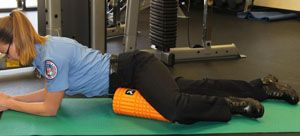“Pain is weakness leaving the body.”
We’ve all heard this motivational quote. And we’ve all pushed through the hurt, proving what? That we are mentally strong? That we can endure what others can’t? We’ve ignored the protests from our brains and bodies to stop — and we’ve ignored the truth.
Constantly ignoring pain will literally break you.
Over time, the pain damages your soft tissue, namely the muscles, to the point that they are full of trigger points and adhesions. The damage takes place in the fascia, a sheath of connective tissue that covers all organs of the body, including every muscle and each fiber within every muscle.
When muscle fibers become stressed, injured or chronically shortened, fascial adhesions and trigger points often develop. These adhesions limit mobility, create tightness and tenderness in muscles, and place undue stress on the joints and vertebrae.
These trigger points, or knots in the muscle, change how you move — and not in a good way.
They can also cause ‘referral patterns’ where a knot in one part of your body creates pain in another part. When you press on your upper trapezius muscle and it shoots pain into your head, that’s a referral pattern.
The problem we see constantly with responders is that due to training, exercises and repetitive postures, trigger points are forming in muscles that you need to safely do your job — particularly in the lower body including the calves, hips and inner and outer thighs.
“Take care of your body. It’s the only place you have to live in”
Thankfully, you can break up these adhesions as well as stimulate the muscles to relax and allow increased elongation of the soft tissue with something as simple as a tennis ball or foam roller.
Technique: Place the ball or foam roller on the area with the knot, and keep pressure on the area for 20 to 30 seconds or until the ‘tenderness’ decreases. Move on to the next point that is tender. Remember to never place the ball directly on bones or joints, especially the spine … muscles are fair game.
 In this case, “pain is weakness leaving the body” does apply. Seek and destroy by finding the most tender spot and parking on it. Healthy tissue does not hurt when you press on it; unhealthy tissue hurts a lot.
In this case, “pain is weakness leaving the body” does apply. Seek and destroy by finding the most tender spot and parking on it. Healthy tissue does not hurt when you press on it; unhealthy tissue hurts a lot.
This technique should allow you to identify and address areas of the body that cause discomfort and limit performance.
Focus on controlled breathing and allow the trigger points to slowly release before moving on to the next one. This process takes time so be patient. Performing a self-massage prior to a workout is a great way to loosen up the muscles and get them prepared to work.
It’s also helpful to keep in mind what can be causing the trigger points to begin with:
- Lower back pain that is non-traumatic often originates in the paraspinals along the thoracic spine (mid-back) and from the glutes.
- Knee pain or soreness that is non-traumatic is often caused by tightness in the Iliotibial Band (IT band) that runs down the outside of the leg.
- Many responders have pain in the front of the hip/leg, specifically on one side. It likely stems from sitting in the truck and your gear placement on the belt, plus how you enter and exit your vehicle. The hip flexors, quad and inner thigh are at play here.
- Tight calf muscles cause or contribute to almost all the lower body issues we see. Plus shin splints are caused by tight calves. Roll the calves both inside and out and then stretch for 90 seconds and your shin splints will be gone in no time.
Most responders are familiar with the aches, pain and stiffness that occur with prolonged sitting, and the massage ball is the perfect answer. This is a very effective form of flexibility training that, when performed consistently and correctly, can have lasting effects. Plus the ball takes up almost no space in your bag. It’s a great way to keep yourself healthy while watching T.V., and especially before a workout.
Do your self-care before all exercise and at least three times per week, if not daily, before or during your shift. You will feel better, move better, be stronger and drastically reduce your chance of getting hurt.













